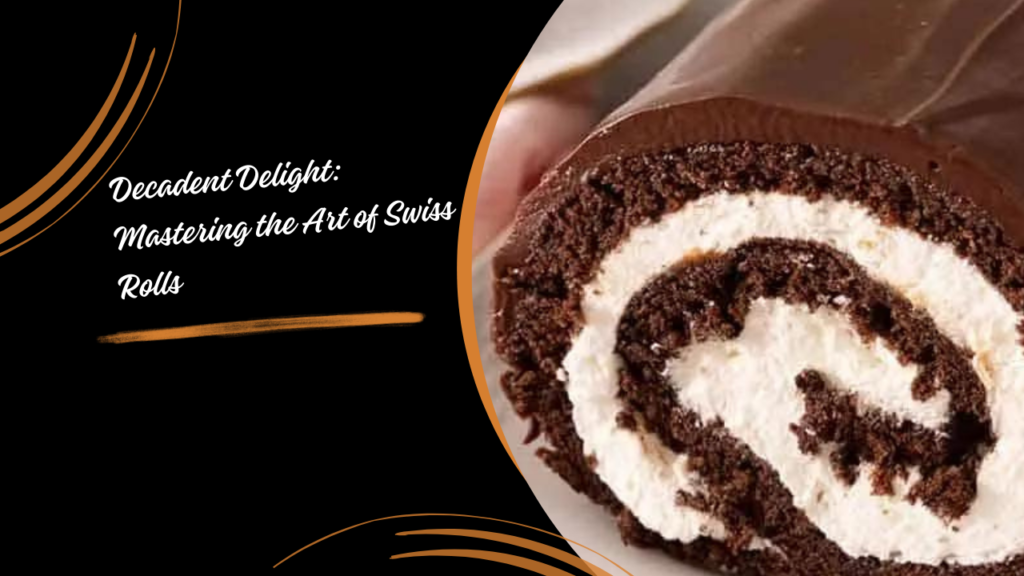A culinary masterpiece known for its soft sponge cake wrapped around a creamy filling, the Swiss roll is a beloved dessert that delights taste buds with each bite. Originating in Central Europe, this delectable treat has found its way into households and bakeries worldwide, enchanting dessert enthusiasts with its simplicity and versatility. If you’re ready to embark on a journey of culinary bliss, join us as we explore the art of making the perfect Swiss rolls.
The Essence of a Swiss Roll:
At its core, a Swiss roll consists of a light and airy sponge cake rolled around a luscious filling, typically cream-based but open to endless variations. What sets a Swiss roll apart is its unique texture – a delicate balance between tender cake and creamy filling, creating a harmonious blend of flavors and mouthfeel.
Ingredients:
Let’s dive into the essential components of a Swiss roll recipe:
For the Sponge Cake:
- 4 large eggs, at room temperature
- 100g (1/2 cup) granulated sugar
- 100g (3/4 cup) all-purpose flour
- 1 teaspoon vanilla extract
- 1/4 teaspoon salt
- Confectioners’ sugar (for dusting)
For the Filling:
- 200ml (1 cup) heavy cream
- 50g (1/4 cup) granulated sugar
- 1 teaspoon vanilla extract
Instructions:
Now, let’s embark on the delightful journey of crafting your very own Swiss roll:
Preheat and Prepare: Preheat your oven to 180°C (350°F). Line a 10×15-inch baking pan with parchment paper, ensuring it extends over the edges for easy removal later.
Whisk Eggs and Sugar: In a large mixing bowl, beat the eggs and granulated sugar using an electric mixer until pale and thick. This step is crucial for achieving a light and fluffy sponge.
Add Vanilla and Salt: Gently fold in the vanilla extract and salt until well incorporated.
Incorporate Flour: Sift the all-purpose flour into the egg mixture in small batches, gently folding after each addition until no streaks of flour remain. Be careful not to overmix to maintain the sponge’s lightness.
Spread Batter: Pour the batter into the prepared baking pan, spreading it evenly with a spatula to ensure a uniform thickness.
Bake: Place the pan in the preheated oven and bake for 10-12 minutes or until the cake is lightly golden and springs back when gently pressed.
Prepare Filling: While the cake is baking, whip the heavy cream, granulated sugar, and vanilla extract together until stiff peaks form.
Roll the Cake: Once the cake is baked, remove it from the oven and immediately loosen the edges with a knife. Carefully invert the cake onto a clean kitchen towel dusted with confectioners’ sugar. Peel off the parchment paper gently.
Assemble: While the cake is still warm, spread the whipped cream evenly over the surface, leaving a small border around the edges.
Roll: Using the kitchen towel to guide you, tightly roll the cake from one short end to the other. Wrap the roll in the towel and let it cool completely, seam side down.
Serve: Once cooled, unwrap the Swiss roll and transfer it to a serving platter. Dust with additional confectioners’ sugar if desired, then slice and serve.
Variations:
The beauty of Swiss rolls lies in their adaptability. Here are some delightful variations to explore:
- Chocolate Swiss Roll: Add cocoa powder to the sponge cake batter for a rich chocolatey flavor.
- Fruit Fillings: Incorporate fresh berries or jam into the whipped cream filling for a burst of fruity goodness.
- Nutella Filling: For a decadent twist, spread a layer of Nutella or your favorite chocolate spread before adding the whipped cream.
- Coffee Flavored: Infuse the sponge cake with coffee extract or espresso powder for a delightful coffee-flavored Swiss roll.
Conclusion:
In conclusion, mastering the art of making Swiss rolls opens up a world of sweet possibilities. Whether you’re a novice baker or a seasoned pastry chef, this delightful dessert is sure to impress with its irresistible combination of light sponge and creamy filling. So, roll up your sleeves, gather your ingredients, and embark on a culinary adventure that’s bound to delight your taste buds and captivate your senses.
FAQs (Frequently Asked Questions)
Can I use a different size baking pan for making Swiss rolls?
While it’s best to use a 10×15-inch baking pan for the ideal thickness of the sponge cake, you can use a slightly larger or smaller pan with adjustments to the baking time. Just ensure the batter is evenly spread to achieve a uniform thickness.
How do I prevent my Swiss roll from cracking when rolling?
To prevent cracking, it’s essential to roll the cake while it’s still warm and flexible. Be gentle but firm when rolling, and use a kitchen towel dusted with confectioners’ sugar to guide the roll. Additionally, avoid overbaking the cake, as it can become dry and prone to cracking.
Can I make a Swiss roll in advance?
Yes, you can prepare the sponge cake and filling ahead of time. Once assembled, tightly wrap the Swiss roll in plastic wrap and store it in the refrigerator for up to 24 hours. However, it’s best to dust with confectioners’ sugar just before serving to prevent it from absorbing moisture.
Can I freeze a Swiss roll?
While it’s possible to freeze a Swiss roll, it’s important to do so without the confectioners’ sugar dusting. Wrap the roll tightly in plastic wrap and then aluminum foil to prevent freezer burn. Thaw the Swiss roll in the refrigerator overnight before serving, and dust with confectioners’ sugar just before serving.
What can I use instead of heavy cream for the filling?
If you prefer a lighter filling or don’t have heavy cream on hand, you can use whipped cream cheese or whipped coconut cream as alternatives. Adjust the sweetness and flavorings accordingly to achieve the desired taste.
Read Also:- Delicious Backed Salmon Recipe: A Flavorful and Nutritious Dish

